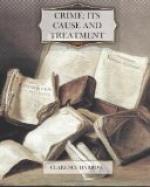True it is often claimed that Jesus repudiated the doctrine of vengeance. The passage of 5th Matthew, 38-30 is often quoted in proof of this assertion—“Ye have heard that it hath been said, an eye for an eye and a tooth for a tooth. But I say unto you, that ye resist not evil, but whosoever shall smite thee on thy right cheek, turn to him the other also.” But the gospels and the other books of the New Testament show plainly that non-resistance was not laid down as a rule for the guidance of mankind, but only as a policy by one sect of the Jews and Christians to save themselves from the Romans. The reason for the doctrine was the belief that resistance was hopeless, and that God who had the power would in his own time visit on the oppressors the vengeance that the Jews and Christians were too weak to inflict. Jesus and the early Christians knew of no people beyond their immediate territory, and they did not appeal to mankind as a whole, or to future generations.
The early Christians believed in judging and in punishment as vengeance, the same as the Jews and other peoples believed in it. (See 13 Matthew 41-43, 23 Matthew 33, 25 Matthew 46.) They believed that the end of the world was at hand; that the coming of the Lord was imminent; that some of that generation would not taste death, and that God would punish sinners in his own time. The New Testament is replete with this doctrine, which was stated and elaborated in the so-called “Revelations of St. Peter.”
Probably this document was composed about the year 150 A.D. and by the year 200 it was read as “Scripture” in some Christian communities. Subsequently it disappeared and was known only by name until a substantial fragment of the document was discovered at Akhmim in Egypt, in the year 1887. A portion of it represents a scene in which the disciples of Jesus ask him to show them the state of the righteous dead, in order that this knowledge may be used to encourage people to accept Christianity. The request is granted and the disciples are shown not only a vision of the delightful abodes of the righteous, but also a vivid picture of the punishments that are being meted out to the wicked. It is interesting to note how the punishments are devised to balance in truly retributive fashion the crimes mentioned. It is this type of tradition that furnished Dante and Milton the basis for their pictures of hell.
The following is the more interesting portion of this document:
And the Lord showed me [Peter] a very great country outside of this world, exceeding bright with light, and the air there lighted with rays of the sun, and the earth itself blooming with unfading flowers and full of spices and plants, fair-flowering and incorruptible and bearing blessed fruit. And so great was the perfume that it was borne thence even unto us. And the dwellers in that place were clad in the raiment of shining angels and their raiment was like unto their country;




